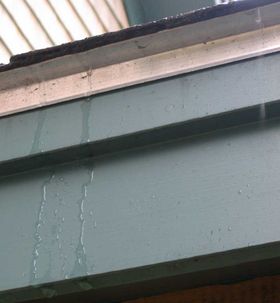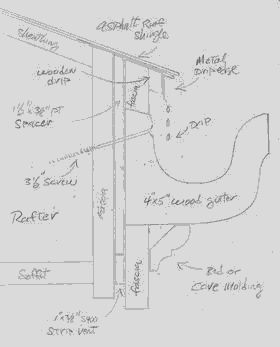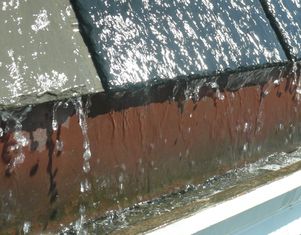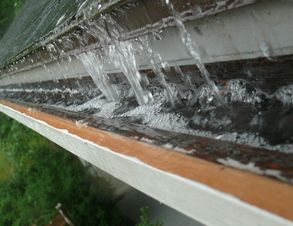
|
The main function of today's widely used metal drip edge is to support the projection of pliable asphalt roofing shingles. Prior to the advent of asphalt roofing, slate and wood shingles needed no support to overhang from the roof edge. From its name "dripedge" one would think it causes roof runoff to "drip". However, as this photo shows, water clings rather than drips from the metal dripedge. To get the water to drip clear of the fascia a 1" x 1" wooden drip must be attached to the top of the fascia, up and behind the metal dripedge like this. This will keep the metal dripedge's apron far enough away from the fascia so the water cannot find and follow it.
|
|
Of course this wood drip will need to be installed before the metal drip-edge is. The problem is no roofer will do carpentry. So if your eaves have this problem the best solution is to pull out the lower apron.
This will wrinkle the metal and render it an eyesore. To solve this I like to cut off the apron off the metal drip edge with a small 4" hand held grinder. The remaining protruding metal supporting the asphalt shingles will still do its job but the apron metal will be missing. ie there will be nothing for the water to follow and it will just drip off the asphalt shingle.
|
|
Prior to the introduction of asphalt shingles all roofs were either slate, or wood shingle. Neither of these needed support to prevent sagging. ie this problem did not exist before the introduction of asphalt roofing. Water gets behind many gutters today because the drip edge does not drip but rather directs the water behind the gutter. If there were a gutter in the above photo where would the water go? That's right, behind the gutter. For this reason aluminum gutter installers like to push the gutter all the way up on the fascia to get the back of the gutter up behind the drip apron of the metal drip edge. This may solve the water behind the gutter problem but it creates an aesthetic problem. Wood gutters are all placed somewhere in center of the fascia. ie there is fascia above and below the gutter. Stuffing the gutter all the way to the top of the fascia really looks awful.
The photo on the right shows how to install a metal drip edge so that it allows the rain water to drip properly, straight down into the bottom of the gutter.
|

|
|
One would think water would drip straight off a roof. And in a heavy rain maybe even shoot off the roof away from the house. Unfortunately there is something more at play than gravity and inertia when it comes to moving water. That something is water's strong surface tension, ie its ability to cling to itself and other objects. This property of water is clearly illustrated in the
photo below. The water running off this roofing is clearly wrapping around the 3/4" thickness of these rubber slate shingles and changing the waters flowing direction back toward the house!
|

|
To protect the wood fascia from constant wetting and to make sure water didn't get behind the gutter they installed the copper flashing seen here in this photo. When this gutter fills, either due to heavy rains or clogged outlet leaders, the water will rise up behind this copper flashing. The water behind this copper will be trapped here for a long time. If the back of the wood gutter was split by driving in large fasteners water will enter deep into these splits and remain there for a very long time, eventually causing rot. Visit this webpage to see how this happens. The better solution would have been the installation of a proper drip that forces the roof runoff to fall straight into the gutter.
|
|
In the photo below one can see the water is following the metal dripedge and from there dropping directly into the bottom of the gutter. This is no accident. The only reason this is happening is because there is a 1"x1" strip of wood (known as a wooden drip) that is fastened on top of the fascia. You can't see it in this photo because its hidden behind the metal drip. you can see it here though. Before the advent of the metal drip edge there was the wooden drip. The wooden drip is still needed for the metal drip to actually "drip".
|
|
The wood drip functions by keeping the drip apron of the metal drip edge away from the fascia so that the water can not find it and run down it (the fascia). Roofers will never be concerned nor care about this important detail. The best way to install this wooden drip is by being eye-ball height with the roof edge. Standing on the edge of the roof bending over and nailing not down as roofers do but toward you is a difficult task. Roofers have one thing in mind when roofing, speed and profit. You'll be lucky if they clean your gutters of their roofing debris when they leave. After all most people never see the inside of their rain gutters.
|

|

